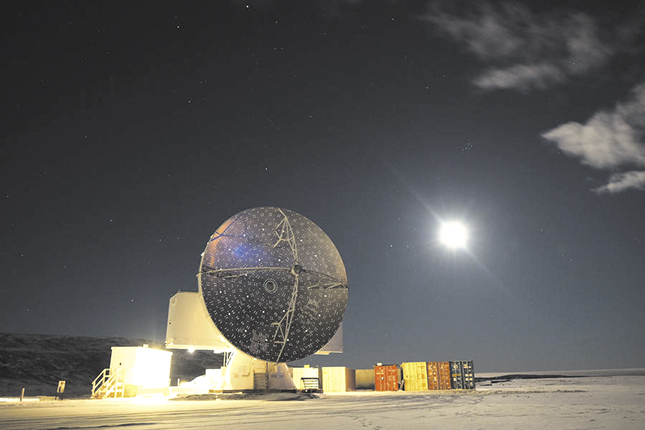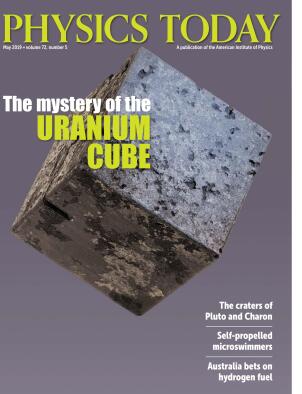Commentary: Basic research in a time of crisis
DOI: 10.1063/PT.3.4194
Pierre Teilhard de Chardin, a paleontologist, geologist, philosopher, and Jesuit priest, wrote, “The history of the living world is an elaboration of ever more perfect eyes in a cosmos in which there is always something new to be seen.” Teilhard’s epigram provides a stunning description of mankind’s longing to understand the natural world, which is to say mankind’s instinct for science.
Today it is essential that science continue to flourish because society desperately needs science to deal with the growing problems due to our changing climate—ocean-level rise, destructive storms, forest fires, drought, and above all, the need for new sources of energy. But society also desperately needs science that although not focused on those problems could be crucial for solving them. A glance at some modern developments shows why.
Teilhard’s phrase “ever more perfect eyes” accurately portrays the evolution of telescopes from crude optical devices at the dawn of the 17th century to today’s space telescopes. That fabulous development was driven by curiosity about the nature of the universe: It was the product of basic research, which is motivated by the joy in understanding the natural world, in contrast to applied research, which is motivated by the need to solve a particular problem. Teilhard’s phrase is a pretty good description of basic research.
Albert Einstein’s search for a theory of gravity—his general theory of relativity—is an iconic example of basic research. The problem he struggled to solve, to create a theory that avoided some inconsistencies in Newton’s theory of gravity, worried hardly anyone else and had no conceivable use, at least not at that time.
A startling consequence of Einstein’s theory is that gravity affects time. A clock on top of a mountain runs faster than an identical clock at sea level, although not by much: At the peak of Mount Everest, a clock runs fast by only a few millionths of a second each month.
Einstein’s prediction for the effect of gravity on time stimulated an experimental search. It originated on 21 January 1945 when a New York Times article carried the headline “‘Cosmic pendulum’ for clock planned.” It was the report of a speech at an American Physical Society meeting in New York City; the speaker was I. I. Rabi, a physicist at Columbia University. Rabi proposed creating a clock whose “ticks” were governed not by the swing of a pendulum but by pulsations in an atom on one of its natural frequencies that could be measured by a technique he had invented.

The Greenland Telescope is one of more than eight in the global Event Horizon Telescope array that aims to observe the immediate environment of black holes. The technology used to synchronize the member telescopes derives from the same basic research that enables detailed, synchronous climate-change measurements by today’s weather satellites. (Photo by Nimesh A. Patel.)

The accuracy of such an atomic clock could be fabulously high. The newspaper article reported, “Professor Rabi said that he would like to see someone build an atomic clock that would be capable of providing, for the first time, a terrestrial check on the Einstein postulate that the gravitational field produces a change in the frequency of radiation.” Thus the creation of atomic clocks sprang directly from curiosity about whether gravity affects the rate of a clock—that is, whether gravity affects time. Lacking any other conceivable application for such an accurate clock, the quest is a perfect example of basic research.
Nobody rushed to build an atomic clock after Rabi’s 1945 talk. The research establishment was in disarray from World War II, and there were some technical barriers. Serious work on atomic clocks started around 1950, and in 1954 the first such clock was demonstrated in the UK. It came to be known as the cesium-beam atomic clock.
In 1956 Norman Ramsey, a former student of Rabi’s, proposed a different type of atomic clock that would be capable of investigating Einstein’s prediction about gravity and time. The device, known as the hydrogen maser, was demonstrated in 1960. Today hydrogen masers are found in most primary timekeeping laboratories along with other atomic clocks that set the international time.
Although the hydrogen maser was created to verify Einstein’s conjecture about time and gravity, its unanticipated applications are noteworthy. For instance, it made the radio astronomy technique known as very long baseline interferometry (VLBI) possible. In each radio observatory, a nearby maser provides a time-stamp signal that permits distant laboratories to synchronize their observations. With VLBI, astronomers can create radio telescope antennas that are effectively the size of Earth; they enable astronomers to create maps of hydrogen throughout the universe with astonishing detail and to look back in time toward the infancy of the cosmos.
Recent progress has been reported on a new frontier of gravity. At the center of our galaxy, a massive black hole is swallowing nearby masses. Matter falling into the black hole vanishes forever, but as the matter crosses a surface called the event horizon, it radiates brilliantly. The Event Horizon Telescope, an advanced VLBI array, is letting us see that process by combining signals from radio telescopes around the world. Last month the EHT team released its first remarkable image, of the central black hole in galaxy M87. The EHT is making it possible to study the predictions of general relativity for phenomena never before witnessed: matter moving in fantastically strong gravitational fields.
The greatest effect of atomic clocks on society is from the creation of the global positioning system. It is fundamentally a timing system, and atomic clocks are at its heart. To my knowledge, nobody had thought about such a system before atomic clocks became a reality, and nobody could have imagined its powers. Today GPS enables the air control systems that guide planes in flight and the ground navigational systems in smartphones and automobiles. It keeps our communications networks and power grids synchronized and is crucial for medical emergency systems. Above all, GPS is critical for understanding the existential threat that climate change is to civilization.
Understanding the global climate requires data on a vast number of variables: radiant energy flow to and from Earth, vertical and horizontal temperature profiles, cloud covering and temperature, sea- and land-surface profiles, ocean-surface temperature and wind speed, global precipitation, water content of the atmosphere, the list goes on. And the quantity of data gathered is enormous.
The primary source of data on Earth’s climate is a fleet of weather satellites in polar orbits, some from the US and some from Europe. The fleet scans Earth’s entire surface four times a day. Often, the satellites work together in pairs, exchanging radar and lidar signals to measure the water content of the highest region of the atmosphere. That particular measurement is vital because most of the atmospheric water is stored there. In addition to the polar fleet of weather observatories, clusters of synchronous satellites from different nations continuously view Earth. The US has two clusters viewing the entire country, one looking east, the other west.
Because few of those global climate measurements could have been made without GPS, it is valuable to keep in mind the system’s origin: mere curiosity about general relativity. GPS is a transformational technology that grew out of basic research. One can cite many other examples of how basic research drives transformational advances. In physics, for instance, investigations of molecules in space by Charles Townes led to the invention of the laser, and studies of atomic nuclei by Edward Purcell and Felix Bloch led to the invention of MRI.
I stress the unexpected rewards from basic research because society urgently needs new ways to deal with the rapidly growing crises of climate change. The latest report of the Intergovernmental Panel on Climate Change (IPCC) concludes that previous reports erred in being too cautious: The time to stem the flow of greenhouse gases is shorter than had been estimated. We face the possibility of a runaway situation in which an increase in global temperature feeds back to accelerate global heating. Such a process would lead to a massive change in climate and a catastrophic elevation of sea level. We face a threat to civilization.
In the US today, support for basic research is dwindling. Opportunities for a career in basic research are decreasing, and our ability to attract excellent students from home and abroad is declining. When considered in the context of the most recent report of the IPCC, the neglect of basic research may be disastrous.
If our civilization succeeds in learning to live in harmony with the natural world, science will have played a crucial role in the transition. The immediate problem in the US is to convince Congress that the situation is urgent. Happily, the years of developing STEM education in the US are starting to pay off. The numbers of scientifically literate citizens and members of Congress are growing. Our representatives will listen if citizens—both scientists and nonscientists—speak up for science and particularly for the value of basic research.
More about the Authors
Daniel Kleppner. (kleppner@mit.edu) Massachusetts Institute of Technology, Cambridge.




